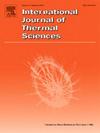Numerical investigation of arc and droplet dynamics in local dry underwater welding under varying ambient pressures
IF 5
2区 工程技术
Q1 ENGINEERING, MECHANICAL
International Journal of Thermal Sciences
Pub Date : 2025-04-14
DOI:10.1016/j.ijthermalsci.2025.109931
引用次数: 0
Abstract
A comprehensive numerical model was developed to investigate the effects of varying ambient pressures on arc and molten metal behaviors in local dry underwater welding (LDUW). The model accounted for the influence of ambient pressure on the thermophysical properties of plasma (mass density, specific enthalpy, specific heat, electrical conductivity, thermal conductivity, and viscosity), ensuring high accuracy of simulation results. The results revealed that increasing ambient pressure significantly concentrated the arc shape and altered the spatial distribution of metal vapor. This constriction fundamentally modified the arc plasma properties by reducing the effective heat transfer area and intensifying the interactions between plasma and molten metal. Key parameters such as arc temperature, plasma velocity, current density, and electromagnetic force all decreased with increasing ambient pressure, leading to reduced energy input to the weld pool. Furthermore, the increased ambient pressure altered the droplet transfer behavior. Higher ambient pressures reduced the droplet detachment frequency, while increasing droplet size due to the enhanced constriction of the arc and the altered surface tension forces at the plasma-droplet interface. To validate the numerical model, experiments were conducted using high-speed imaging to capture the real-time droplet processes, and the arc temperature distribution wad measured using spectroscopic methods. The experiments results showed excellent agreement with the simulation data, confirming the reliability of the model. This study provides valuable insights into the impact of ambient pressure on LDUW, offering a solid foundation for optimizing welding parameters to improve process efficiency and weld quality under varying high ambient pressure conditions.
不同环境压力下局部干式水下焊接中电弧和熔滴动力学的数值研究
建立了一个综合的数值模型,研究了不同环境压力对局部干式水下焊接中电弧和熔融金属行为的影响。该模型考虑了环境压力对等离子体热物理性质(质量密度、比焓、比热、电导率、导热系数、粘度)的影响,保证了仿真结果的高准确性。结果表明,环境压力的增加使电弧形状明显集中,并改变了金属蒸气的空间分布。这种收缩通过减少有效传热面积和加强等离子体与熔融金属之间的相互作用,从根本上改变了电弧等离子体的性能。电弧温度、等离子体速度、电流密度和电磁力等关键参数都随着环境压力的增加而降低,导致焊缝熔池的能量输入减少。此外,环境压力的增加改变了液滴的传递行为。较高的环境压力降低了液滴分离频率,同时由于电弧收缩增强和等离子体液滴界面表面张力的改变而增加了液滴尺寸。为了验证数值模型,采用高速成像技术进行了实验,以实时捕捉液滴过程,并采用光谱方法测量了电弧温度分布。实验结果与仿真数据吻合良好,验证了模型的可靠性。该研究为研究环境压力对LDUW的影响提供了有价值的见解,为优化焊接参数以提高不同高环境压力条件下的工艺效率和焊接质量提供了坚实的基础。
本文章由计算机程序翻译,如有差异,请以英文原文为准。
求助全文
约1分钟内获得全文
求助全文
来源期刊

International Journal of Thermal Sciences
工程技术-工程:机械
CiteScore
8.10
自引率
11.10%
发文量
531
审稿时长
55 days
期刊介绍:
The International Journal of Thermal Sciences is a journal devoted to the publication of fundamental studies on the physics of transfer processes in general, with an emphasis on thermal aspects and also applied research on various processes, energy systems and the environment. Articles are published in English and French, and are subject to peer review.
The fundamental subjects considered within the scope of the journal are:
* Heat and relevant mass transfer at all scales (nano, micro and macro) and in all types of material (heterogeneous, composites, biological,...) and fluid flow
* Forced, natural or mixed convection in reactive or non-reactive media
* Single or multi–phase fluid flow with or without phase change
* Near–and far–field radiative heat transfer
* Combined modes of heat transfer in complex systems (for example, plasmas, biological, geological,...)
* Multiscale modelling
The applied research topics include:
* Heat exchangers, heat pipes, cooling processes
* Transport phenomena taking place in industrial processes (chemical, food and agricultural, metallurgical, space and aeronautical, automobile industries)
* Nano–and micro–technology for energy, space, biosystems and devices
* Heat transport analysis in advanced systems
* Impact of energy–related processes on environment, and emerging energy systems
The study of thermophysical properties of materials and fluids, thermal measurement techniques, inverse methods, and the developments of experimental methods are within the scope of the International Journal of Thermal Sciences which also covers the modelling, and numerical methods applied to thermal transfer.
 求助内容:
求助内容: 应助结果提醒方式:
应助结果提醒方式:


